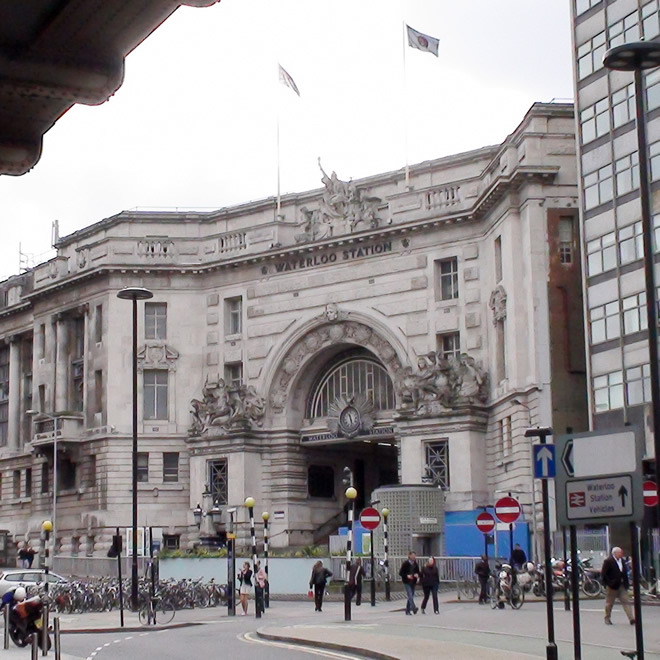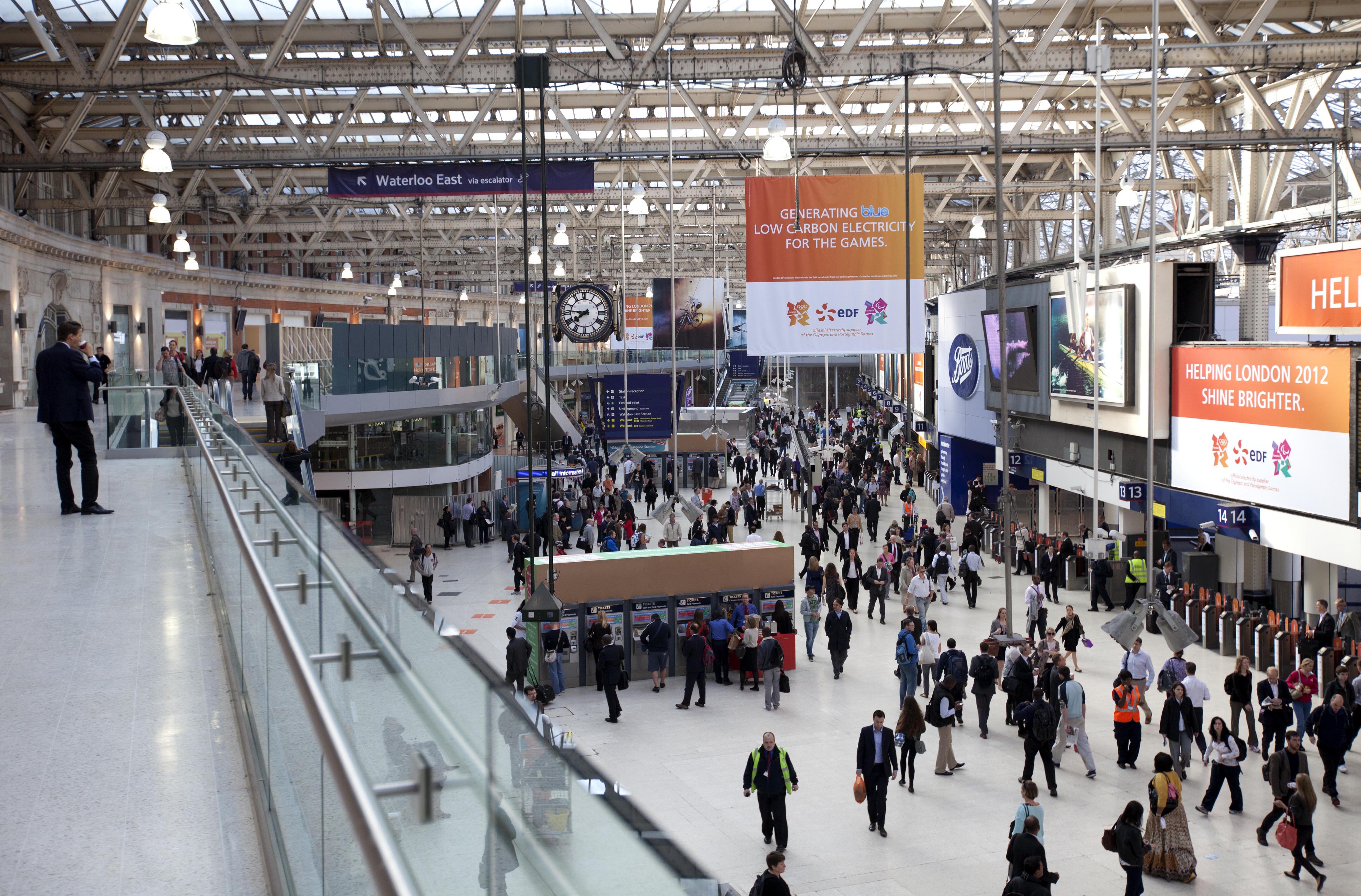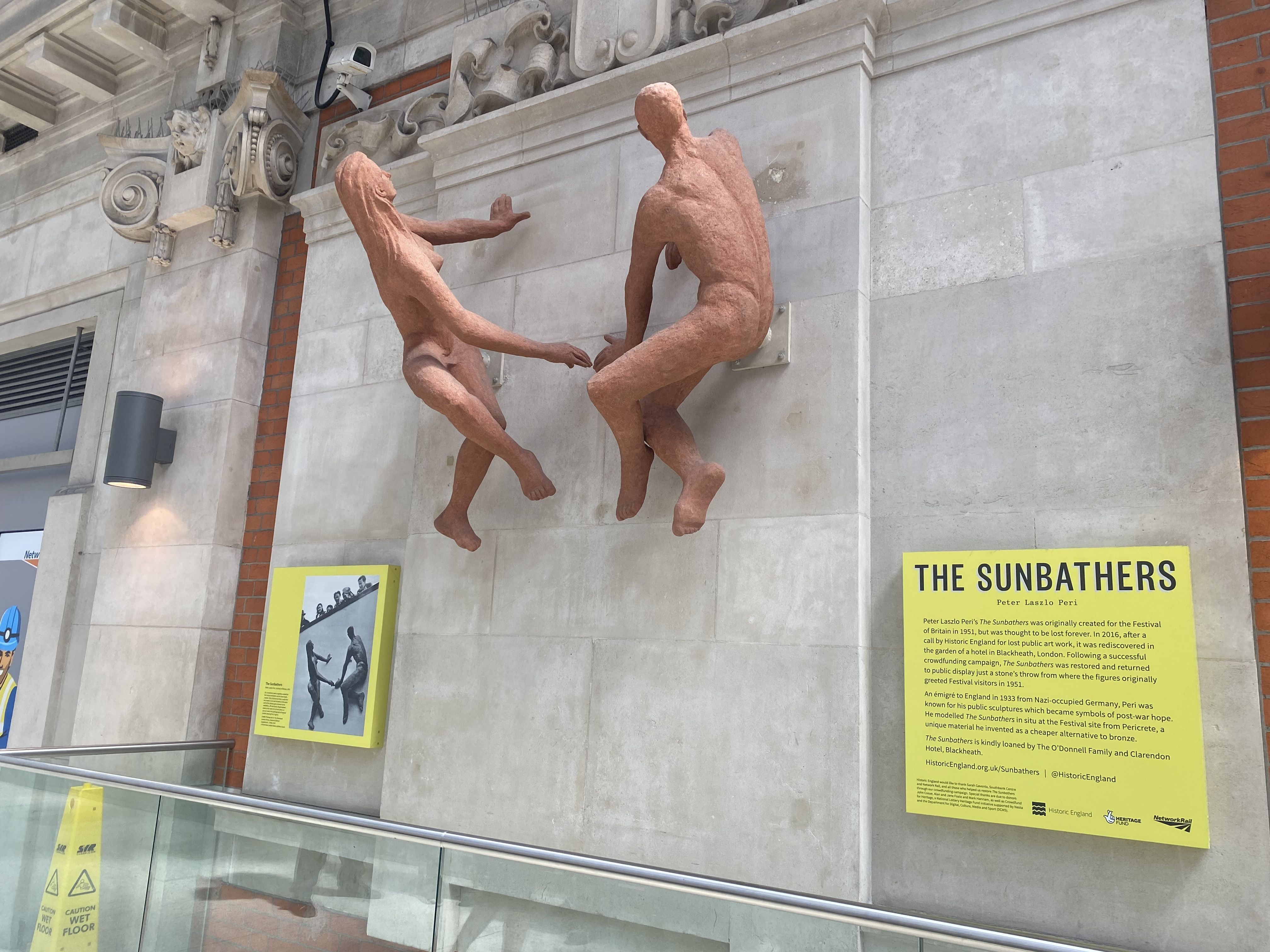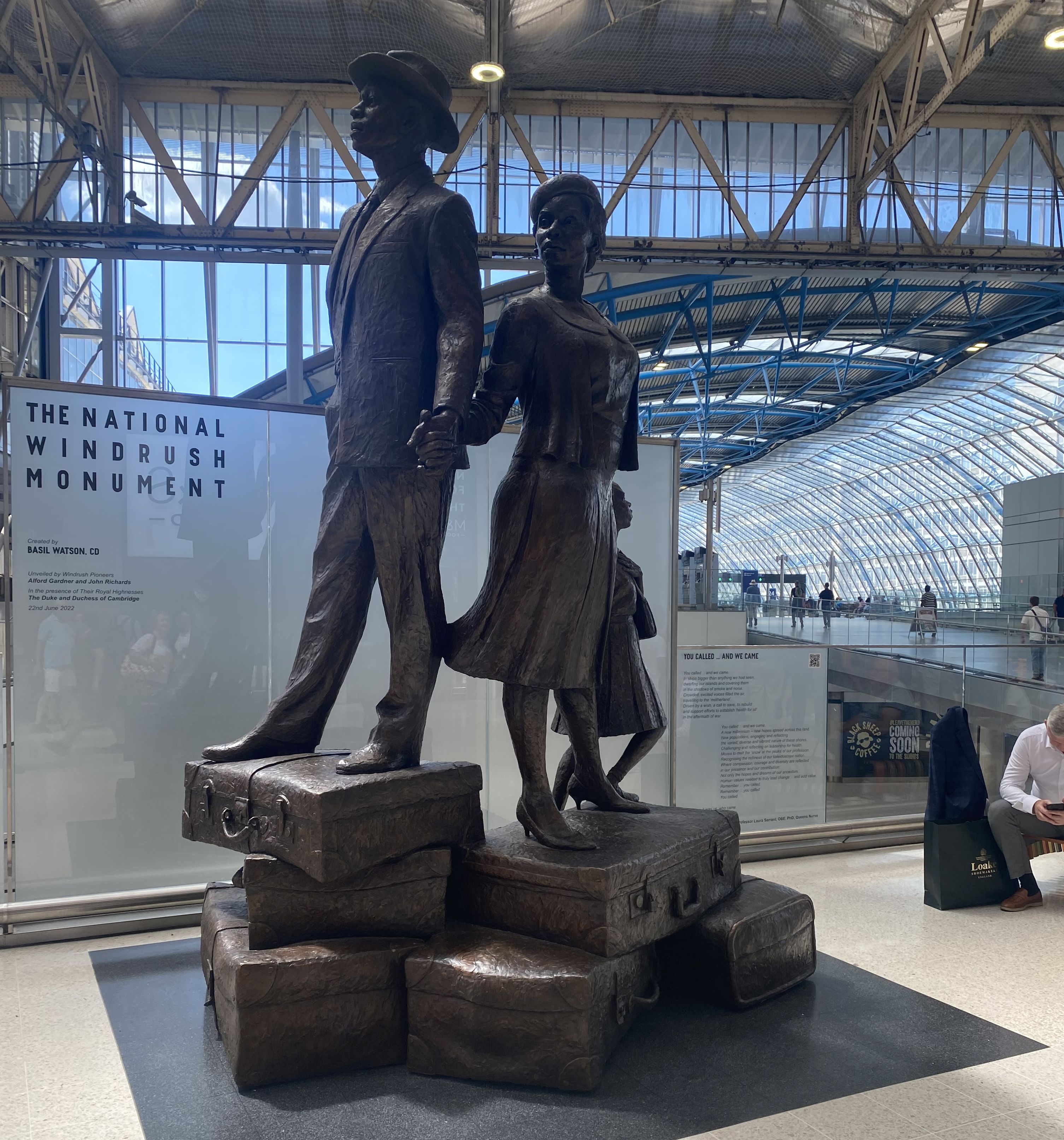Article from BTNews 8 AUGUST 2022
ON TOUR: Waterloo - The Station
In London with a couple of hours spare? Try the unlikely location of Waterloo Station. There is real heritage around. The station originally opened in 1848 but was totally remodelled between 1909 and 1922.
Try the unlikely location of Waterloo Station. There is real heritage around. The station originally opened in 1848 but was totally remodelled between 1909 and 1922.
It is also probably Britain’s biggest transport hub, in 2019 moving 99m passengers. You may even have seen it in a movie film without even knowing. Its wide and light curved concourse being perfect as a film location.
I joined Blue Badge Guide Rachel Kolsky on one of her walking tours. Rachel pointed out that the excursion took two hours, was mostly under cover and included the seven stations that over the years have made up the Waterloo complex.
Rachel pointed out that the excursion took two hours, was mostly under cover and included the seven stations that over the years have made up the Waterloo complex.
Of course, it is nothing to do with ABBA but you try telling that to some youngsters. Waterloo means “The end”, their version a love affair. It was for Napoleon outside Brussels in 1815. The station’s actual name came via the nearby Waterloo Bridge, originally called ‘Strand Bridge’ but renamed in 1817 just before it opened. It was demolished in the late 1930s with today’s bridge finally completed in 1945.
The main pedestrian entrance to Waterloo Station, constructed in a pre-mobility era (it’s all steps) is called the Victory Arch and was opened by Queen Mary 21 March 1922. It commemorates the railway staff lost in WWI. Next door, the massive 1960s office block, Elizabeth House is about to be demolished for redevelopment. The environmentally clean plans look exciting with roof gardens and a clear view of The Thames.
In times gone by passengers for the Boat Train to Southampton could arrive by car, drive across the concourse onto the platform and step right into a carriage. The original Queen Mary awaited.  In 1934 a Moderne Style News Theatre opened at the end of Platform 1. In the days before TV this is where you could see newsreels from all around the world, and local events bought to you by Pathe News and Movietone. It showed cartoons from the 1950s and was to finally close in 1970 by which time it was showing full length feature films as the Classic Cinema Waterloo. In 1988 it was demolished.
In 1934 a Moderne Style News Theatre opened at the end of Platform 1. In the days before TV this is where you could see newsreels from all around the world, and local events bought to you by Pathe News and Movietone. It showed cartoons from the 1950s and was to finally close in 1970 by which time it was showing full length feature films as the Classic Cinema Waterloo. In 1988 it was demolished.
Another major innovation which will be forgotten by later generations is the original London Eurostar terminal which the Queen opened in May 1994. It was always going to be a stopgap operation until the completion of High Speed 1 to St Pancras in 2007.
This is now the home of platforms 20−24 for destinations to the west of London including Windsor, as favoured by Queen Victoria. Visitors to London might note that Windsor & Eton Riverside is served from Paddington Station. The former government-owned British Airports Authority (BAA) proposed using the platforms as “Airtrack”, an alternative southern approach to Heathrow using mostly existing rail track to Staines and a link to the airport. The problem with that route, and a later one by Wandsworth Borough Council, it passed by level crossings which could slow the service down. A southern route into Heathrow is still in the development stage by a group called Heathrow Southern Railway Ltd.
The former government-owned British Airports Authority (BAA) proposed using the platforms as “Airtrack”, an alternative southern approach to Heathrow using mostly existing rail track to Staines and a link to the airport. The problem with that route, and a later one by Wandsworth Borough Council, it passed by level crossings which could slow the service down. A southern route into Heathrow is still in the development stage by a group called Heathrow Southern Railway Ltd.
Waterloo East station is connected these days by a smart aluminium bridge over Waterloo Road with trains to Kent, and in reverse to Charing Cross across the river, which you can plainly see just one mile away across the Thames. The station opened in 1869 as Waterloo Junction for the South Eastern Railway. The platforms here are lettered to avoid confusion with the numbered ones at the main station.
Deep down in the bowels of the station are platforms for the Bakerloo, Jubilee and Northern lines, and also the shortest of all Transport for London’s (TfL) Underground lines, the Waterloo & City Line known as “The Drain”, just 1.5miles from Waterloo, under the Thames, to Bank. In a normal year it will carry 16m passengers annually linking commuters from southern suburbs to The City. One hundred and fifty years ago you took a horse-drawn carriage to The City over the then Waterloo Bridge. One station completely forgotten about is the terminus for the London Necropolis Railway, in Westminster Bridge Road, built to take mourners (and bodies) from London to a cemetery in Brookwood, Surrey. The offices dating from 1902 and replacing the original station opened in 1854, still stand but the station itself was destroyed by bombing in 1941 and never reopened.
One station completely forgotten about is the terminus for the London Necropolis Railway, in Westminster Bridge Road, built to take mourners (and bodies) from London to a cemetery in Brookwood, Surrey. The offices dating from 1902 and replacing the original station opened in 1854, still stand but the station itself was destroyed by bombing in 1941 and never reopened.
Waterloo Station is constantly being redeveloped and is still suffering from shops closed during the pandemic including the popular Carluccio's restaurant. Foyles bookshop is closed at this time whilst being redeveloped. It is now part of Waterstones.
There are various artworks and memorials along the main concourse wall including ‘Sunbathers’ a restored piece from the Festival of Britain, a replica campaign medal commemorating the 200th anniversary of the 1815 Battle of Waterloo and a stained-glass window with the London and South Western Railway's crest, Waterloo’s original railway company which merged with others in 1923 to form Southern Railway.
New to the station is a national Windrush statue (very recently unveiled by HRH Duke and Duchess of Cambridge on 22 June 2022). Whilst it will be seen by many over the years, to this writer it is in the wrong place, the connection between Tilbury, where the ship docked, and Waterloo is vague. The Kindertransport memorial is more appropriate at Liverpool Street Station, the arrival place in London of those young refugees from Nazi Europe.  From the old Eurostar site a must is a visit to Leake Street and The Vaults, a celebration of urban art, dining and entertainment located in the undercroft below Waterloo Station.
From the old Eurostar site a must is a visit to Leake Street and The Vaults, a celebration of urban art, dining and entertainment located in the undercroft below Waterloo Station.
Eight former railway arches have been brought back to life to provide a community of independent restaurants, bars and entertainment spaces that are united by their approach to celebrate the creativity of urban culture.
Part of London's longest legal graffiti wall (300m) it has made its name as a democratic cultural venue for street art. An exciting street-culture led spot which leads into Lower Marsh, the home of an authentic street market supervised by the London Borough of Lambeth with a variety of vintage shops, pubs, bookshops, art galleries, independent coffee spaces and restaurants featuring food from many ethnic origins. At the end of Lower Marsh is the famous Old Vic Theatre and a short walk back to Waterloo Station.
If it is raining on your self-paced walk there is no need to spent time in the open.
Rachel is sponsored by Network Rail and rumour has it that its Chairman Andrew Haines, he of course holding in the past the same position at the CAA, is proposing to join a tour.
www.networkrail.co.uk/wp-content/uploads/2022/05/London-Waterloo-Station-Map.pdf
http://www.golondontours.com
To book your place on one of the upcoming tours visit
www.eventbrite.co.uk/e/historic-tour-of-waterloo-station-tickets-303427408547
OUR READERS' FINEST WORDS (All times and dates are GMT)
All comments are filtered to exclude any excesses but the Editor does not have to agree with what is being said. 100 words maximum
